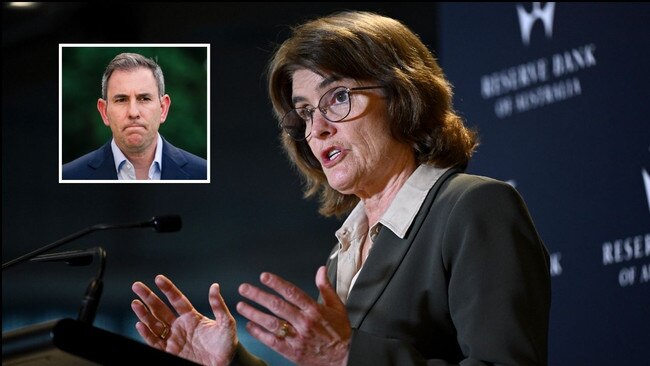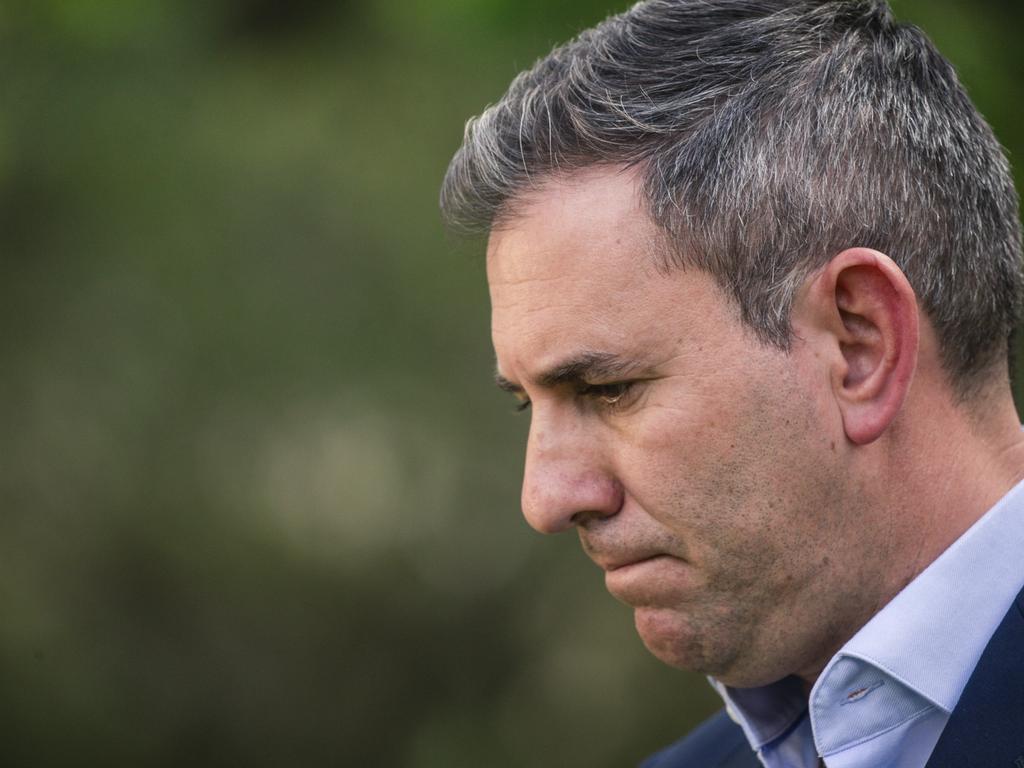Underlying issue ruins Treasurer Jim Chalmers’ inflation headline
Michele Bullock and Anthony Albanese are on a collision course over pre-election rate cuts after the RBA warned price pressures remained too high and it wouldn’t lower rates on the basis of inflation data distorted by cost-of-living measures.

Michele Bullock and Anthony Albanese are on a collision course over pre-election rate cuts after the central bank warned underlying price pressures remained too high and it would not lower rates on the basis of inflation data that had been distorted by governments’ cost-of-living measures.
Following rate reductions by central banks in the US, Canada, China, the European Union, Britain and New Zealand, the RBA board on Tuesday held the cash rate at 4.35 per cent, ruled out a near-term cut and did not “explicitly consider” another hike despite concerns over sticky inflation.
Ahead of volatile monthly consumer price index figures on Wednesday that are expected to show headline inflation falling to just 2.7 per cent in the year to August, the RBA governor said the central bank’s preferred underlying inflation indicator was not expected to return to target until the end of next year.
After coming under private and public attack from senior Labor figures including ALP national president and former treasurer Wayne Swan, who claimed the RBA was “punching itself in the face” after holding rates steady last month, Ms Bullock said inflation was “still too high”.
As the Prime Minister and Jim Chalmers focus on falls in headline CPI to convince voters that Labor’s spending and relief measures are working, Ms Bullock said government-funded cost-of-living and energy measures were temporarily lowering inflation.
While acknowledging that households were struggling with mortgage, rent and bill shocks, Ms Bullock reiterated that the central bank could not “rule anything in or out”, and that its board must be confident that inflation was moving “sustainably towards” its target band of 2 to 3 per cent before it could deliver rate cuts.
“We really need to see underlying inflation coming back down toward the target,” Ms Bullock said. “The message clearly from the board is that in the near term it does not see interest rate cuts.”
Facing rising political pressure ahead of next year’s election to deliver rate cuts, which economists are not predicting until February, Ms Bullock said the RBA understood higher interest rates were hurting households but added: “We only have one instrument – it’s the interest rate. The government has more tools at its disposal, but we only have the one instrument.”
After the RBA board’s statement on Tuesday said headline inflation was expected to fall further temporarily, as a result of federal and state cost-of-living relief, the Coalition accused the Albanese government of “attempting to manipulate headline inflation”.
While headline CPI measures total inflation across the economy, the RBA’s preferred underlying inflation indicator strips out more volatile price changes.
Ms Bullock said intervention by governments to provide cost-of-living relief and reduce energy prices would lower headline inflation but was “not really reflective of the underlying inflation pulse”.
Betashares chief economist David Bassanese said government efforts to “artificially bring down inflation – perhaps with a view to encourage the RBA to lower interest rates – is fooling no-one, least of all the RBA”.
The RBA does not expect headline inflation, skewed by government subsidies, to return sustainably to its target band until the end of 2026.
After Dr Chalmers this month warned that higher interest rates imposed by the central bank were “smashing the economy”, Mr Swan backed in his former chief-of-staff by accusing the RBA of “putting economic dogma over rational decision-making”.
Asked to respond to Mr Swan’s comments on Tuesday, Ms Bullock said: “What we are doing is what we think is best to maintain this narrow path of bringing inflation back down, because it’s still too high, it’s still not back in the band.”
Dr Chalmers said interest rates had not gone up “for the best part of a year”, which indicated combined monetary and fiscal strategies were working.
“When it comes to the Reserve Bank and the government, we have the same objective of getting on top of inflation without ignoring the risks to growth in our economy,” Dr Chalmers said.
“We’ve designed our cost-of-living relief to help take some of the edge off these price pressures in our economy rather than make them worse. There’s nothing artificial about helping people.”
Despite efforts by Mr Albanese and Dr Chalmers to spruik the government’s efforts to lower inflation, the majority of households remain unconvinced.
New polling obtained by The Australian reveals voter confidence that inflation levels will decrease over the next 12 months remains low at 31 per cent.
An SEC Newgate Mood of the Nation poll of 1611 Australians, conducted between September 10 and 14, found 69 per cent of voters were not confident inflation would moderate over the year.
Opposition Treasury spokesman Angus Taylor said the RBA board had made clear that there must be a “sustainable reduction in inflation, not a temporary reduction in inflation that’s manipulated by the government”.
“The government is attempting to manipulate headline inflation, and the Reserve Bank is seeing straight through government manipulation,” Mr Taylor said.
“The government needs to focus on doing the real job, which is to bring core inflation down so that interest rates can come down, so Australians’ standards of living can be restored to where it should be.”
Mr Taylor seized on the RBA board statement’s reference to spending growth among international students and tourists to claim higher migration was fuelling inflation.
Mr Albanese, asked what message he had for voters regarding rate cuts, said: “My government is doing everything we can to put downward pressure on inflation. We’ve seen it halved down to 3.5 per cent. What we want to see is more moderation of inflation going forward. But at the same time, we’re looking after people where we can on cost-of-living pressures, whilst making sure that any action is consistent with putting that downward pressure on inflation, which is why we’re producing budget surpluses.”
Australian Bureau of Statistics inflation figures for July showed headline CPI at 3.5 per cent and underlying inflation at 3.8 per cent, which was the same level recorded in January.
As central banks across the globe move to cut rates in response to falling inflation, slowing growth and a weakening in domestic labour markets, Ms Bullock said: “We are looking at the data, and we’re not ruling out we might raise, we’re not ruling out we might cut. We think we’re in the right spot at the moment. When the time comes, then we’ll have a discussion about how urgent in one direction or the other is it that we move, and how big those moves will be.”
Ahead of Dr Chalmers meeting Chinese counterparts at the Strategic Economic Dialogue in Beijing on Thursday – marking the first visit by an Australian Treasurer in seven years – the RBA board statement warned that geopolitical uncertainties remained pronounced. “The outlook for the Chinese economy has softened and this has been reflected in commodity prices,” the RBA board said.
“There also remains a high level of uncertainty about the outlook abroad. Some central banks have eased policy, although they note that they are removing only some restrictiveness and remain alert to risks on both sides, namely weaker labour markets and stronger inflation.”
Queensland Labor Premier Steven Miles, who is on track for a heavy defeat in next month’s state poll, defended his big-spending pre-election sweeteners and urged the RBA to cut rates “as soon as they possibly can … they should begin to reduce interest rates, particularly now that we’ve seen the United States Fed begin to reduce theirs.”






To join the conversation, please log in. Don't have an account? Register
Join the conversation, you are commenting as Logout